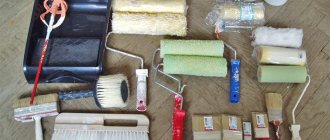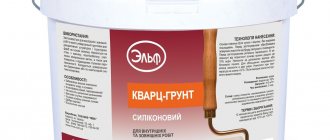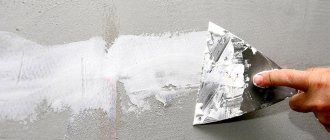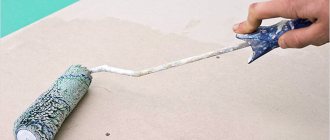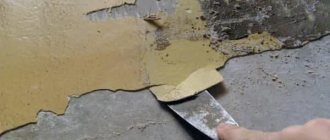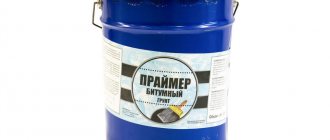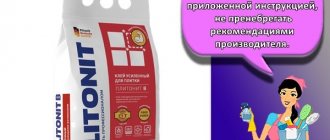Specifications
| Kinds | Primer, concentrate |
| Application area | For external and internal work |
| Finish type | Tile; Putty; Dye; Plaster; Drywall; Wallpaper. |
| Compound | Aqueous dispersion of acrylate copolymers |
| Film color: | light yellow |
| Density: | about 1.0 kg/dm3 |
| Transportation and storage temperature: | from +5 to +35°С (for the “Frost-resistant” version up to 5 freezing periods at –40°C are allowed) |
| Application temperature: | from 0 to +35°С |
| Shelf life: | No more than 24 months from the date of manufacture. Avoid direct sunlight! |
| Package: | Primer in plastic containers of 1 l, 5 l and 10 l. Concentrate 10l. |
| How to dilute | Water |
| Application method | Brush, roller |
These quality indicators are valid for an ambient temperature of +20°C and a relative air humidity of 60%. In other conditions, the technical characteristics of the material may differ from those indicated.
How long does it take to dry?
Depends on temperature, air humidity, primer consumption and the absorbency of the base.
Ceresit ST 17 is a quick-drying primer. Complete drying time up to 2 hours .
Consumption per 1m2
If the base absorbs moisture strongly, then when applying the first layer, dilute 1 part of the primer with 1 part of water.
According to the manufacturer:
0.1–0.2 l/m2 for a single application, depending on the absorbency of the base.
Reviews on the Internet:
Per room 39 sq. m. one 5-kilogram canister was enough for me. But this is taking into account that for the first treatment the soil must be diluted 1:1.
irecommend.ru
An excellent primer, but the inscription “100 m2” is too optimistic. On truly absorbent substrates - such as a screed laid by crooked workers - this primer has to be poured “sea style” directly from a canister, otherwise it will be absorbed without any effect, like a spilled glass of water in the Sahara Desert. I would estimate the actual consumption for such cases as 15-20 square meters per 10-liter canister.
leroymerlin.ru
Advantages and disadvantages of primer
The product penetrates perfectly into any surface and is suitable for most used building materials. The concentrate can often be diluted with water, which reduces its cost by 1 square meter. m. Other advantages:
- presence of protective properties;
- improving the characteristics of the existing coating;
- quick drying;
- environmentally friendly, no harm to health;
- Possibility of use in kindergartens and hospitals;
- no special requirements for storage and transportation;
- mold protection;
- economical price;
- transparency.
There are few downsides to this product. Users call one of them yellow, which is not suitable if subsequent painting with white paint is planned. It can be painted over by applying paint in 2 layers. Another disadvantage is the rapid absorption of the material into those surfaces on which it was accidentally spilled; such stains are difficult to remove. We are talking about laminate and linoleum, which must be protected from soil. However, following all the recommendations makes the use of the product profitable and successful, because its advantages significantly outweigh the disadvantages.
Advantages and disadvantages
| Advantages | Minuses |
|
|
Application area
Well suited for coating surfaces made of:
- concrete, including light cellular concrete;
- cement, cement-sand and cement-lime mixtures;
- plasters of various types, including lime and gypsum;
- fibreboard, particle board and cement particle board;
- brickwork from bricks of all brands;
- natural stone.
- Also used for treating anhydrite screeds.
Once on the surface, the mixture quickly penetrates the structure of the base material and firmly connects with it. After drying, the primer noticeably reduces the material’s ability to absorb moisture and increases the strength of the base surface, which is also important. In addition, the primer binds dust that remains on the surface of the material even after very thorough cleaning and reduces the strength of the connection between the base and decorative coatings and plasters. The consequence of these actions is an increased level of adhesion of various materials to the base. The primer improves the quality of self-leveling mixtures due to the fact that their spreading over the surface becomes noticeably better, and the likelihood of the formation of bubbles, which reduce the strength of the leveling mixtures, is reduced to zero. In addition, mixtures applied over the primer do not dry out and have a normal hardening regime.
Instructions
Preparing the base
The base must be dry and free of dirt. It is necessary to remove cement stains, splashes of plaster, and old paint, in addition to acrylic or water-based paint, from the surface.
Pre-cover windows and doors with masking tape.
Application
The canister should be shaken before using the composition. If you are working with the material for the first time, it is convenient to make a test layer. And apply the primer to a small area to see the absorbency and calculate the number of layers.
Apply the composition with a roller or compressor. If the area is difficult to access, then use a small brush. Do not allow any leaks.
It is not advisable to exceed the consumption rate.
After applying the first layer, after 2 hours, if necessary, you can apply a second one.
Work should be carried out in dry conditions, at air and base temperatures from 0 to +35°C and relative air humidity not exceeding 80%.
Excess fresh solution is removed with water, and dried solution with solvent. Simply rinse the tools with water.
Applying primer
To coat with Ceresit CT-17 primer, use a roller or a wide and narrow brush. A narrow brush is necessary in any case, since it works on hard-to-reach places. Spraying using a compressor is also acceptable.
When processing Ceresit CT-17, it is recommended to consider some tips:
- there should be no puddles or drips;
- comply with consumption standards, only in special cases is excess consumption allowed;
- wait for complete drying: for smooth surfaces up to 6 hours, for surfaces with a significant amount of pores up to 24 hours;
- After completing processing work, it is necessary to rinse the instrument with warm water.
There is a way to check the quality of priming: glue is dripped onto the primed surface. If the stain begins to absorb quickly or dries unevenly, apply at least one more coat of primer.
If multiple coatings of Ceresit CT-17 are taken into account, then the first layer is applied in a diluted state (1k1 with water).
What are Ceresit primer mixtures?
These compositions are universal, they have a water-dispersion base, are made from synthetic resins, and are very popular because they penetrate deeply into the substrate being treated, be it plaster, putty or a brick wall. Thanks to their use, adhesive characteristics are improved, and the walls do not dry out prematurely, so cracks do not form, which could lead to rapid destruction of the finish.
There are several varieties of Ceresit soils, each type has its own technical characteristics, scope of application, functionality, each variety has a different consumption per 1 square meter. The most popular modifications are ceresit primer st 17 and st 16. In addition to these, grade 19 is also produced, which is used for treating concrete buildings before plastering them. Each of the modifications meets high standards and requirements and has all the necessary certificates confirming high quality.
Ceresit ST 16
This type of primer composition is widely known among specialists in the field of finishing. This primer is made on a water-dispersion basis. It is used when performing interior and exterior finishing work; this modification can only be applied to a prepared base, before applying plaster. Thanks to the use of this primer product, it is possible to qualitatively prepare the base being treated, which will guarantee its strong and reliable adhesion to the finishing material, so the coating will be functional and attractive for many years.
Distinctive properties of Ceresit primer
The use of Ceresit primer allows you to perform several types of work at the same time. It helps to level the surface, increase adhesion, and create an aesthetic appearance.
In addition to this, the absorbency and porosity of finishing building materials is reduced. This allows surfaces to be painted evenly in the same tone.
How to properly prepare the base
Surface preparation should be taken seriously. Despite the fact that the primer holds the outer layer of the base material together, it will not hold the peeling sections of the plaster. These areas are identified by tapping and removed to a solid base. Irregularities are sealed with plaster mixtures and smoothed with putty. Before sealing large gaps, they are primed.
The crumbling surfaces are swept with a hard broom until the intensity of the shedding becomes insignificant. Cement laitance and fragments of dried splashes of plaster or putty are completely removed from the surface. All types of paint, except water-based paint, are completely removed.
The base must be dry, so after finishing the plastering work you must wait 14 days, and after puttying - 24 hours.
If doors or windows are installed in the openings, they are covered with film using masking tape.
Ceresit ST 17
This deep penetration primer is universal, so it can be used to treat all types of external and internal surfaces. The technical characteristics of the Ceresit St 17 primer allow it to be used for the following purposes:
- to reduce the moisture content of the base before gluing, laying tiles or stone tiles;
- strengthening the walls before applying a layer of plaster;
- treating floors before using leveling floor products;
- processing of gypsum plaster or cellular concrete walls;
- strengthening bases on which water-based or acrylic paints are applied;
- processing of wood chipboard and plasterboard materials;
- before painting the building or installing insulation boards;
- processing of cement-bonded, brick buildings, as well as those products that are treated with formaldehyde products.
Many experts believe that before wallpapering, it is necessary to prime the walls. This opinion is justified, because priming products protect walls from destruction and improve adhesive properties.
Preparing the Base Layer
To carry out the work, it is necessary to initially prepare the base - it must be cleaned of various types of contaminants (oils, fats, dust, bitumen, varnishes and paints).
- Problem areas of the surface should be cleaned, defective areas should be removed and appropriate repairs made.
- Paint coatings with a low level of adhesion should be completely eliminated, and the seams should be sealed using putty.
Doors, windows and other elements that are not planned to be processed should be covered with film to prevent contamination.


